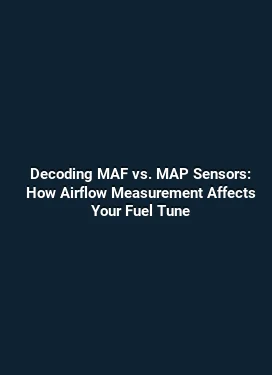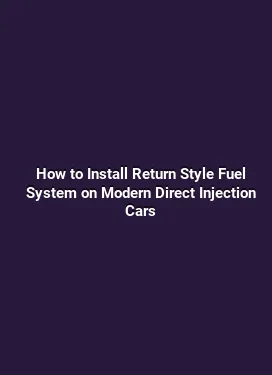How to Install Air-to-Water Intercooler System Complete Setup
Installing an air-to-water intercooler (AWIC) can significantly improve charge-air cooling, throttle response, and overall performance for turbocharged or supercharged engines. This in-depth guide focuses on the intake and fuel system integration, laying out a practical, field-ready approach that covers planning, component choice, installation, calibration, and long-term maintenance. The process emphasizes compatibility with modern engine management, coolant routing strategies, and sensor placement to ensure reliable operation under real-world driving conditions.
Understanding the Air-to-Water Intercooler System and Its Place in the Intake & Fuel Chain

AWIC systems operate by circulating coolant through a dedicated heat exchanger that sits between the compressor outlet and the intake manifold. The coolant absorbs heat from the charged air, reducing its temperature before it enters the engine. This cooling effect lowers intake air density, reduces the likelihood of knock, and can enable more aggressive timing and fuel maps when paired with a capable engine control setup. In the broader intake and fuel pathway, the AWIC interacts with the charge pipes, intercooler plumbing, throttle body or intake manifold, MAP/MAF sensors, fuel injectors, and the engine control strategy that governs fuel delivery and ignition timing.
Key benefits of an AWIC installation include improved consistent charge cooling under high boost, enhanced performance consistency across varying temperatures, and potential gains in power density without extending the heat soak period of the charge air. Proper integration requires attention to coolant routing, pressure differentials, electrical control, and the manner in which the intercooler affects air-fuel ratios and injector duty cycles under load. Those considerations guide component selection and placement decisions from the outset.
Pre-Installation Planning: Assessing Vehicle Requirements and System Goals
Before lifting a wrench, compile a clear picture of performance targets and compatibility constraints. Start with engine configuration, compression ratio, turbocharger or supercharger size, and the current intake plumbing layout. Evaluate whether the existing charge piping can accommodate the AWIC core dimensions and the auxiliary pump, reservoir, and heater elements typical of a complete setup. Map out electrical access for sensors and the cooling pump, ensuring there is a reliable power source and a safe mounting location that minimizes vibration impact and heat exposure to sensitive electronics.
Another essential planning step is determining coolant specification. Most AWIC systems rely on a dedicated coolant loop distinct from the engine’s cooling system, though some designs share a heated coolant circuit with the vehicle’s radiator. Decide on coolant type (ethylene glycol vs. propylene glycol or alternative eco-friendly formulations), fill pressures, and reservoir sizing based on desired coolant capacity and the thermal load expected during sustained high-boost operation. The routing plan should also account for possible future upgrades, such as higher-boost configurations or different intercooler cores, to minimize rework down the line.
Choosing the Core, Pump, and Sensor Suite

The intercooler core is the heart of the setup. Core geometry, fin density, and flow characteristics determine cooling efficiency and pressure drop. A larger core with high-efficiency fins can reduce charge air temperature more effectively but may impose greater pressure losses if piping is constrained. The electric pump should deliver a steady flow rate that keeps the entire loop primed under all operating conditions, including idle and high-load bursts. A well-designed reservoir and expansion capability help manage thermal expansion and make maintenance easier.
Sensors provide critical feedback for safe and predictable operation. A temperature sensor placed at the intercooler outlet gates the cooling response, while a pressure sensor monitors coolant circuit integrity. Some systems also integrate an ambient air temperature sensor to adjust the perceived intake charge. Ensure the engine management or a dedicated controller can read these inputs and translate them into meaningful adjustments to fuel delivery and ignition timing without introducing lag or instability.
System Components and Their Roles in the Intake & Fuel Path
An air-to-water intercooler installation comprises several interdependent components. A typical complete kit includes the intercooler core, water-to-air heat exchanger, specialty water pump, reservoir, hoses and clamps, fittings for coolant routing, electrical harnesses, a thermostat or flow control valve, and mounting hardware. In the intake path, the AWIC sits between the compressor discharge and the throttle body or intake manifold, often replacing or augmenting the stock intercooler route. On the fuel side, several implications arise: cooler air can support denser mixtures, enabling higher injector duty cycles and potentially allowing more aggressive fueling strategies as the engine management recalibrates for the increased air density.
Routing coolant lines demands careful attention to supply and return orientation to maximize heat transfer while minimizing pressure drop. The supply line should draw from a pressure-fed point that avoids air entrapment and reduces the risk of vapor lock in cold starts. The return line should feed into the reservoir or into the cooling circuit with consideration for thermal expansion. Finite element or computational flow considerations can guide hose bend radii and clamp placement to reduce turbulence and vibration-related wear.
Integrating with Intake Piping and Throttle Body
Connecting the AWIC to the intake path requires attention to charge-air piping diameters, couplers, and alignment to minimize leak paths. Use heavy-duty T-bolt clamps in high-boost regions, and consider silicone hoses with appropriate heat resistance and fatigue properties for long-term reliability. Ensure smooth transitions at junctions to prevent vortices that could trap moisture or cause pressure fluctuations under boost. If the throttle body or intake manifold is not directly compatible with the AWIC outlet, an adapter or redesigned pipe segment may be needed to maintain uniform velocity and minimize pressure drop.
Balancing intercooler placement with under-hood heat management is also critical. Position the AWIC to minimize exposure to radiant heat from the exhaust or exhaust-related components, and consider shielding or shielding materials if necessary. A well-planned layout reduces thermal cycling on hoses and supports consistent high-load performance across a broad operating envelope.
Installation Steps: From Preparation to Calibration
Begin with a clean workspace and a detailed parts inventory. Photograph or document the stock routing to facilitate reassembly if needed, and use manufacturer-recommended torque specs for all fittings. Start by securing the intercooler core in its chosen mounting location, ensuring a solid foundation that tolerates engine movement and vibration. Attach the water heat exchanger and plan coolant line routing in a way that avoids contact with hot exhaust components or moving belts.
Next, run the coolant lines from the pump to the heat exchanger, paying attention to flow direction. Install the pump in a location with access to a power source and where vibration or heat will not compromise operation. Mount the reservoir where it remains visible for quick checks and fills, and ensure the overflow path is clear. With coolant lines connected, perform a leak test using a non-operating system pressure to verify tightness before proceeding to integration with the electrical system.
Electrical integration involves connecting the pump and any control solenoids or valves to a switched power source and a dedicated ground. If the system features a temperature or flow switch, wire these sensors to the engine management interface or a dedicated controller. After initial electrical checks, fill the coolant loop with the chosen coolant and bleed the system to remove air pockets. A careful bleed process prevents air locks that could compromise cooling performance during the first startup.
Once the hardware is confirmed leak-free and mechanically sound, focus on software or mapping. The engine management must recognize the altered charge-air temperature dynamics and adjust fueling and ignition as needed. Some setups require a conservative starting map with gradual enrichment and timing advances to allow the system to reach thermal equilibrium safely. Progressively push toward the target power curve while monitoring air temperatures, fuel trims, and knock events. Use real-time data logging to observe trends and catch anomalies early.
Calibration Practices: Tuning for Reliability and Performance
Calibration is a process of translating cooler intake air into predictable engine behavior. Begin by validating that the AWIC’s coolant temperature correlates with the expected charge-air temperature drop under a range of loads. Compare measured intake air temperatures with predicted values to ensure the system behaves as designed. If there is a discrepancy, re-check the coolant flow rate, heat exchanger efficiency, and flow paths to identify potential restrictions or heat soak issues.
Fuel system implications are a critical consideration. Cooler air allows the engine to tolerate higher fueling without overheating the charge, enabling performance gains, but this must be balanced against emissions and reliability constraints. Start with modest fuel enrichment and gradually advance until you reach the optimal power-to-torque ratio while staying within safe ignition timing limits. Monitor injector latency and duty cycles to detect if injectors are approaching their maximum capability, especially at high boost and wide-open throttle conditions.
Boost management and wastegate control should be revisited in light of improved charge cooling. If the system includes an electronic boost controller, verify that its response characteristics align with the faster and cooler charge air, ensuring stable operation during rapid throttle changes. The end goal is a smooth, predictable power delivery with minimal timing pull during high-load bursts, achieved through a harmonious balance of cooling capacity, airflow, and fuel control.
Maintenance, Safety, and Long-Term Reliability
Regular maintenance is the backbone of reliability for an AWIC installation. Check coolant levels and top up as needed, following a consistent bleed procedure to purge air. Inspect hoses for signs of hardening, cracking, or loosening clamps, particularly at bend points or near heat sources. Replace any aging hoses with reinforced variants designed for high heat and pressure. Periodically inspect the heat exchanger for signs of fouling, which can impair heat transfer efficiency; consider a routine cleaning interval if the operating environment includes significant dust or oil mist exposure.
Electrical connections should be examined for corrosion and secure mounting. Vibration can loosen connectors over time, so use lock washers or thread-locking compounds where appropriate and re-tighten after track days or off-road sessions. Maintain a clean engine bay to minimize debris that can migrate into the intercooler or piping. In high-performance applications, monitor pressure differentials across the intercooler core to detect potential clogging or leaks that could degrade performance and safety margins.
Practical Considerations: Real-World Scenarios and Upgrades
In applications where ambient temperatures are extreme, consider an AWIC with a larger core or enhanced coolant flow to sustain performance. If space is limited, some builders opt for compact cores that provide adequate cooling with careful routing and high-quality fittings. In setups that demand ultra-high efficiency, pairing the AWIC with an intercooler shroud or air-directing accessories can further improve airflow across the core, reducing thermal bottlenecks during sustained high-boost operation.
For enthusiasts pursuing data-driven improvements, instrumenting the system with high-resolution temperature and pressure sensors in strategic locations yields actionable insights. Logging intake air temperature, coolant temperature, intercooler outlet temperature, and boost pressure provides a rich dataset to quantify the cooling performance across a range of driving styles. Use this data to refine fuel maps and ignition timing progressively, ensuring that the gains in cooling translate into tangible power and drivability improvements rather than transient boosts in performance that cannot be sustained.
Final Thoughts on a Robust AWIC Installation
A well-executed air-to-water intercooler installation delivers meaningful improvements in charge air temperature management and overall engine response. The integration with intake and fuel systems hinges on careful planning, precise mechanical routing, and disciplined calibration. By paying close attention to core selection, coolant routing, sensor placement, and software tuning, a robust AWIC setup can provide reliable performance gains across a broad operating spectrum while maintaining long-term durability and safety.






